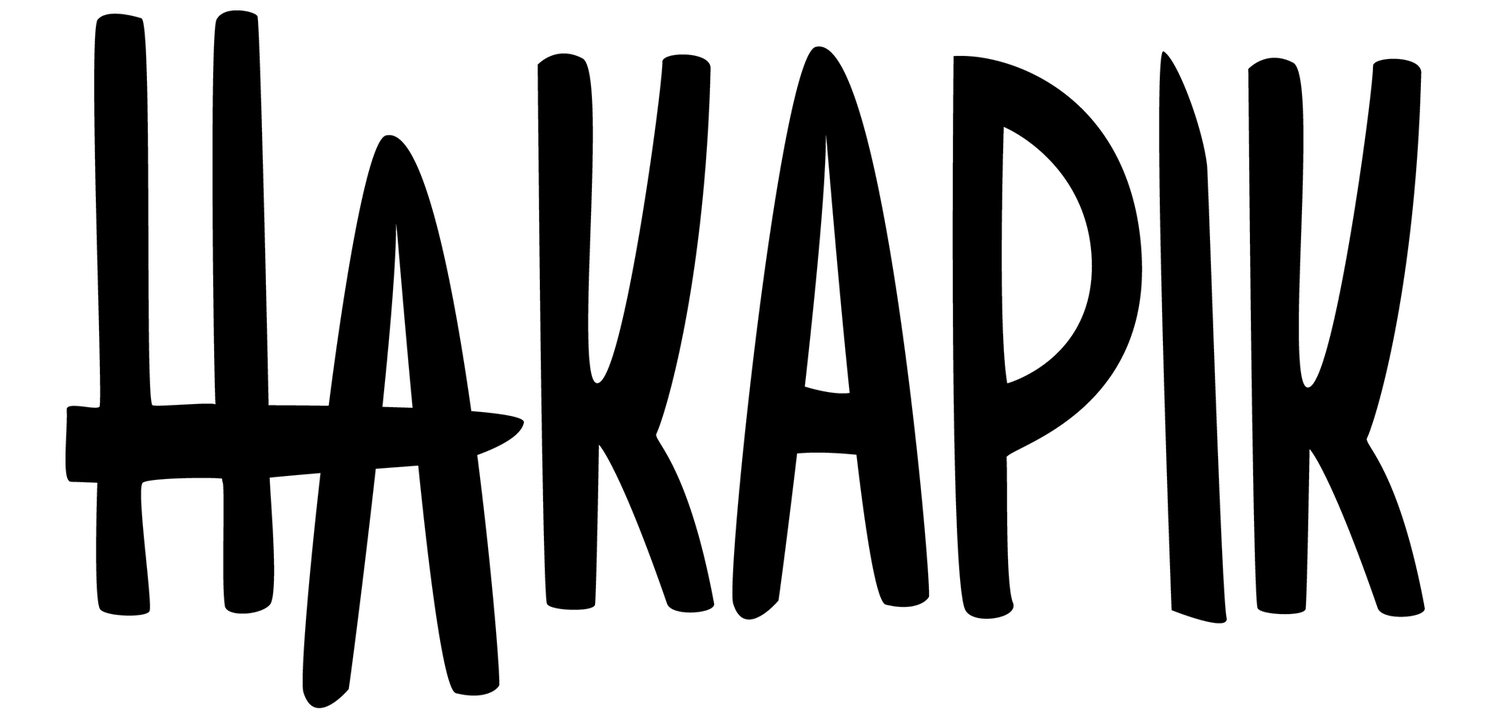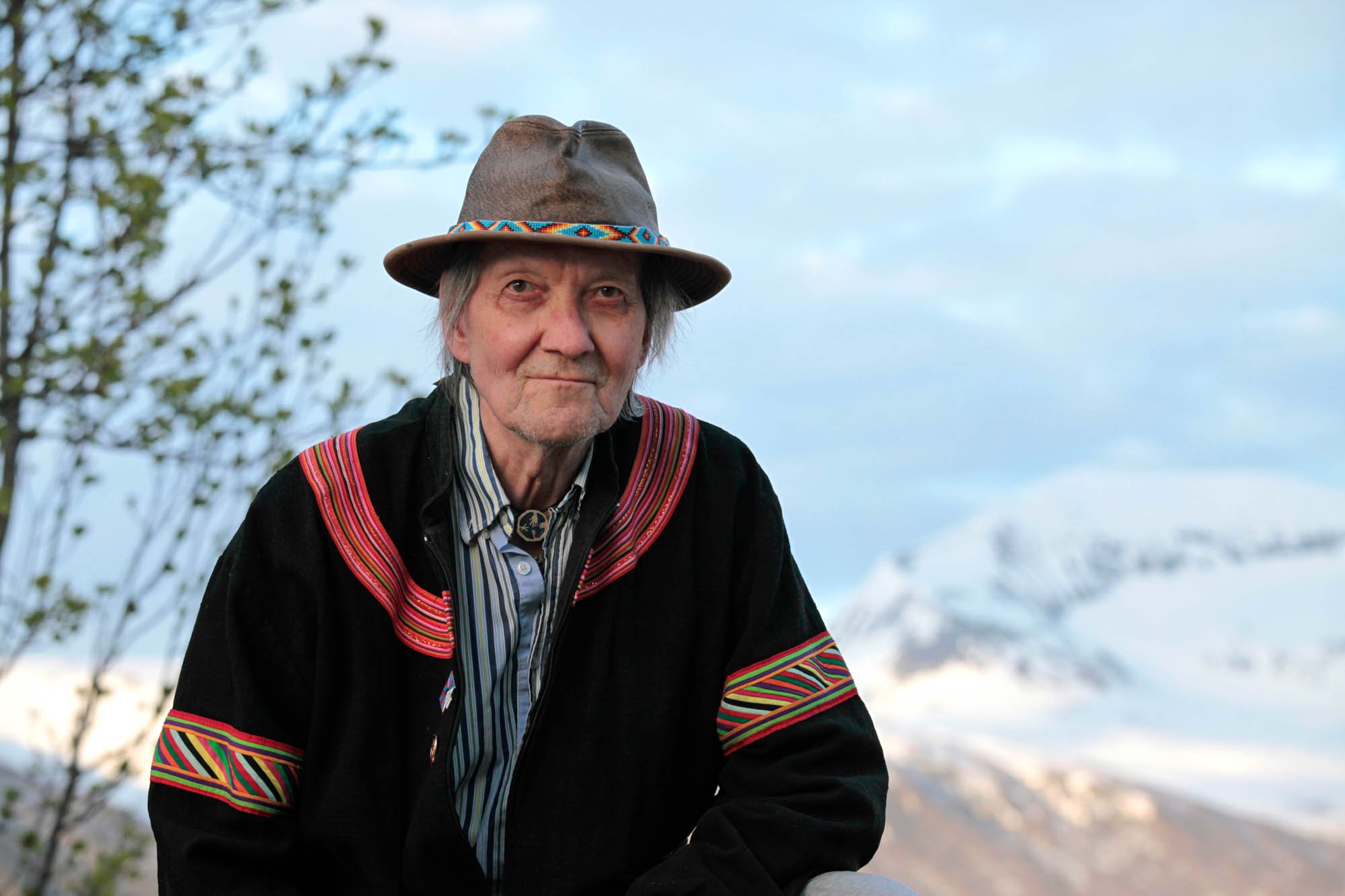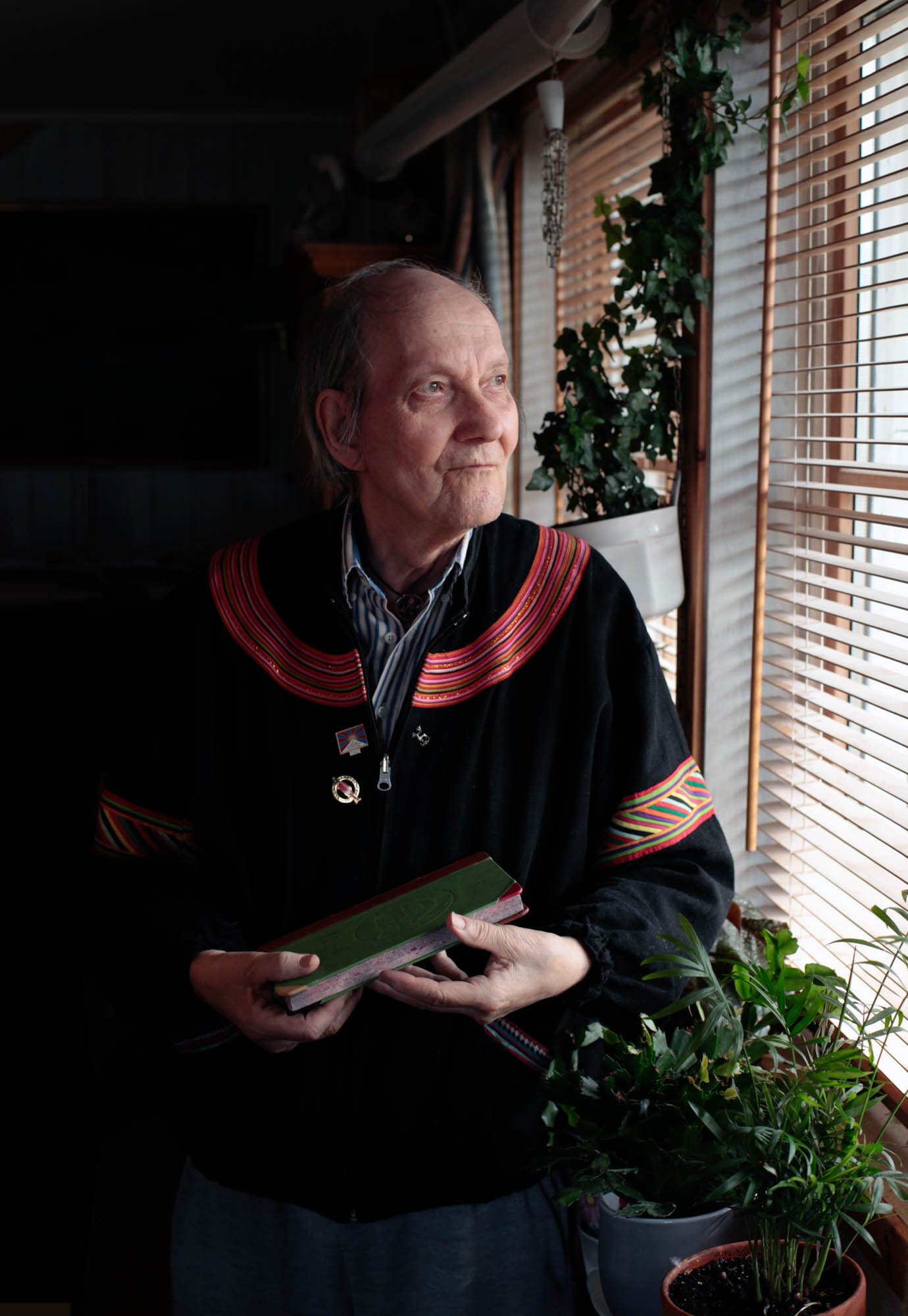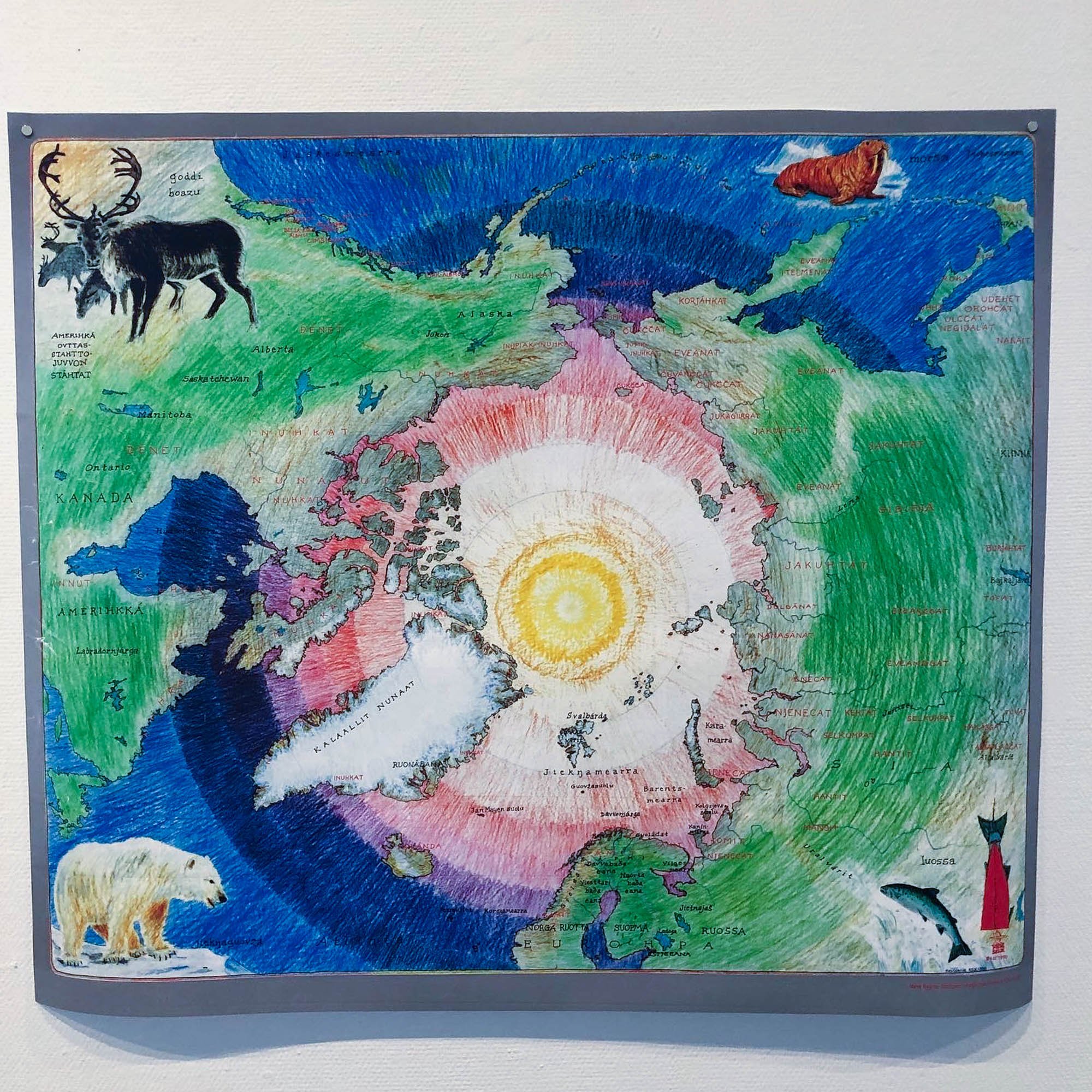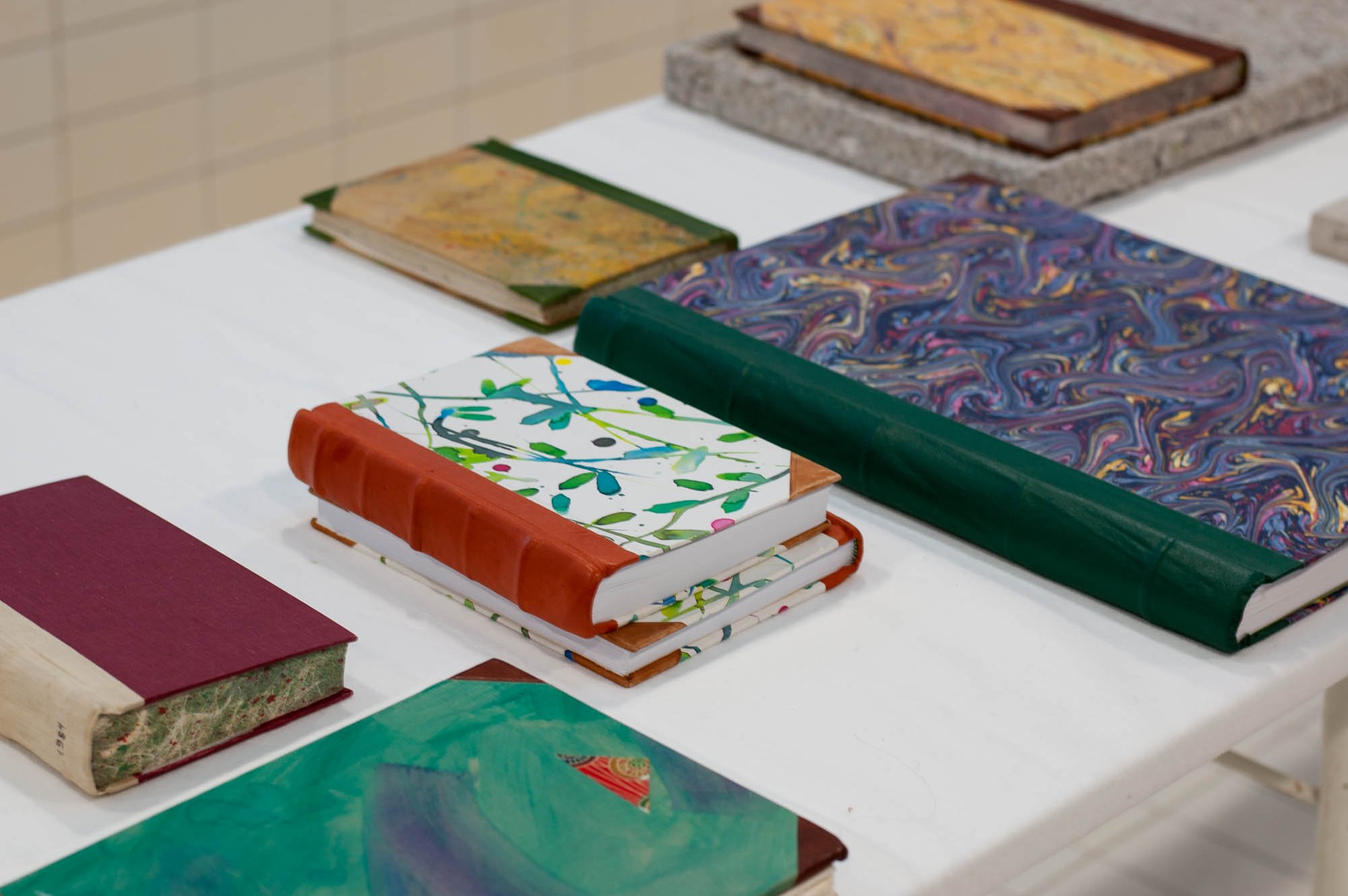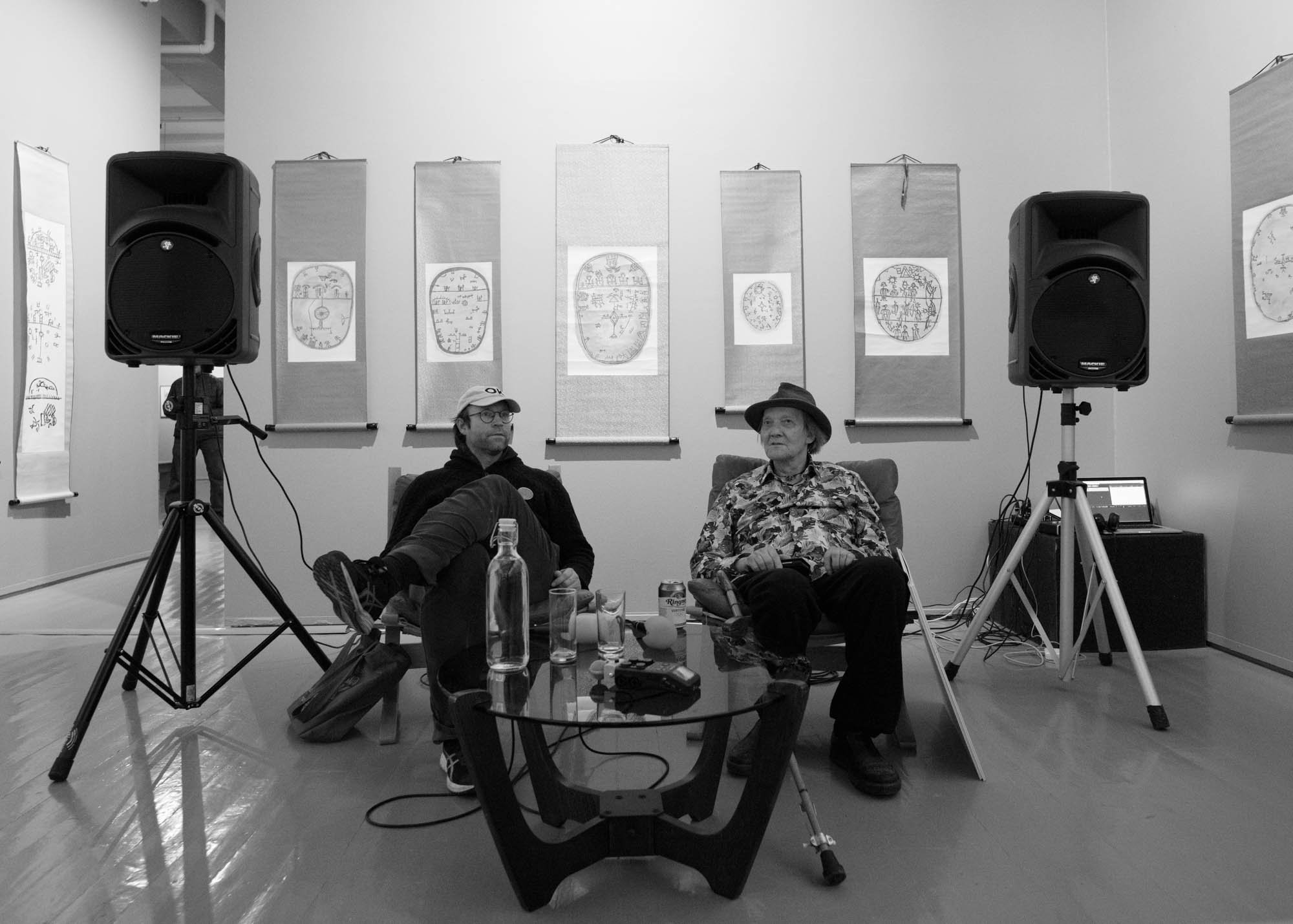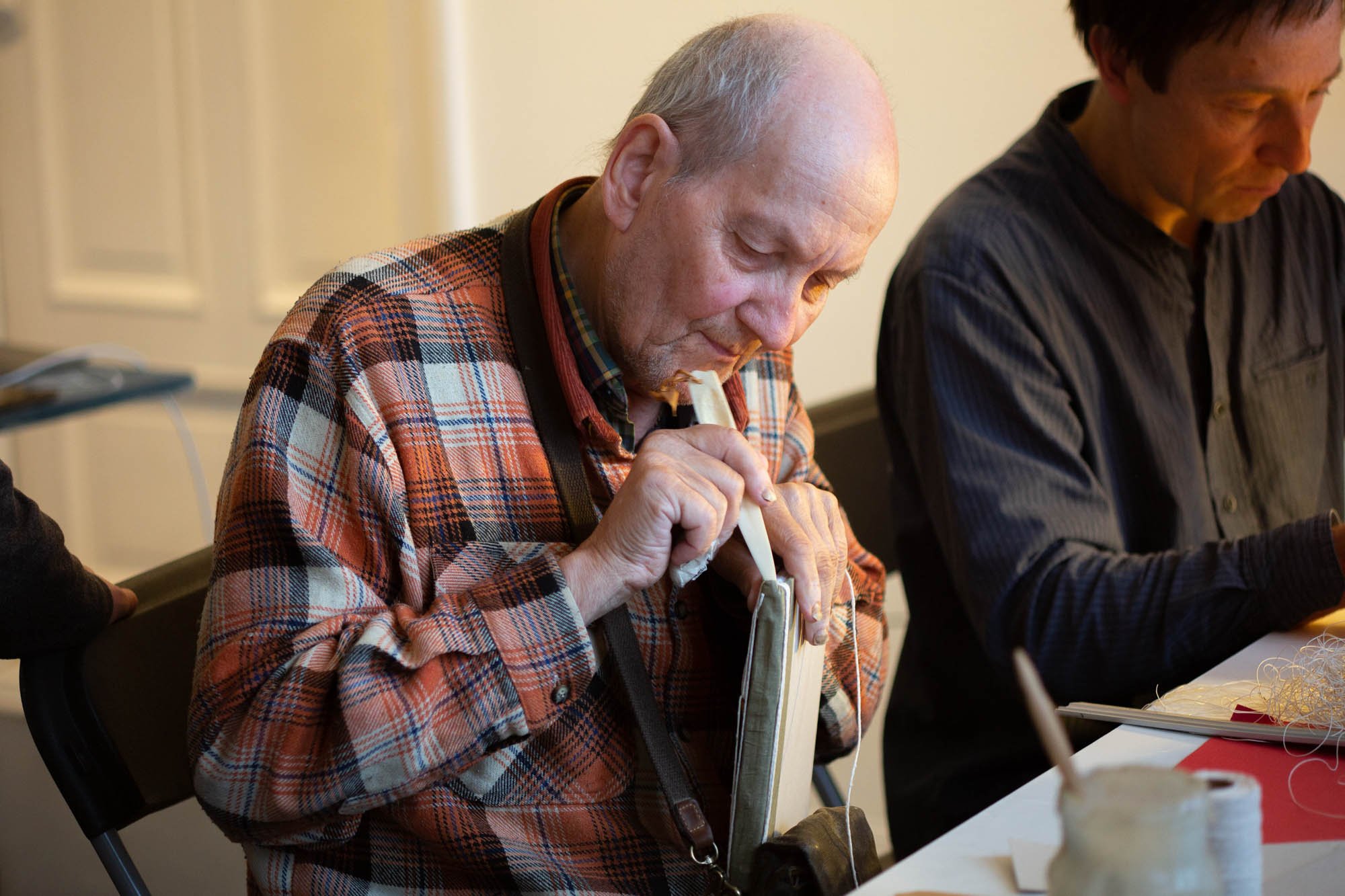Hans Ragnar Mathisen: Portrait of a life devoted to art and activism
Interview with Hans Ragnar Mathisen/Elle-Hánsa/Keviselie, Tromsø, 2021.
Written by Marion Bouvier
Footnotes at the bottom.
Hans Ragnar Mathisen, by his Sámi name Elle-Hánsa and also known as Keviselie, has become a legendary artist in Tromsø, as witnessed during the opening of his first solo exhibition at the Kunstforening in Tromsø, his adopted city, when he also received the John Savio prize. At the occasion of the exhibition’s opening, it looked like Elle-Hánsa was finally recognized for the inventive, highly productive, and groundbreaking artist he has been for the past 50+ years.
A large crowd gathering Sámi political and cultural figures, local artists, friends from Tromsø and Sápmi, as well as passers-by assembled on a sunny September day in the Kunstforening’s park for the vernissage of the exhibition entitled ČSV- Terra Cognita. Curated by Gry Fors from the Árran Lule Sámi Center and Leif Magne Tangen, intendant of the Tromsø Kunstforening, the 2-floor-exhibition is both a retrospective and a tribute to an oeuvre that spans decades – and that in many ways defies attempts to sum it up.


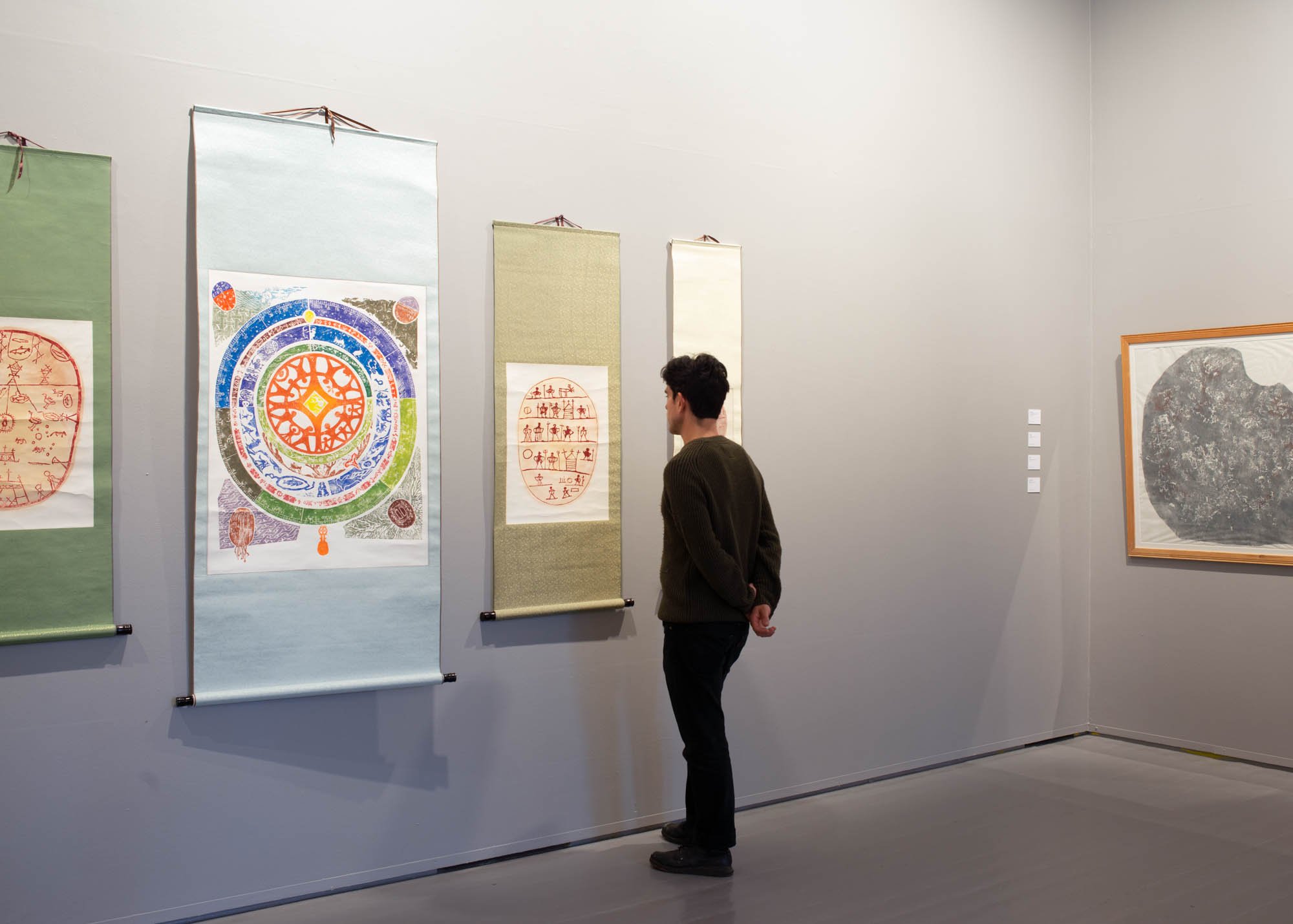
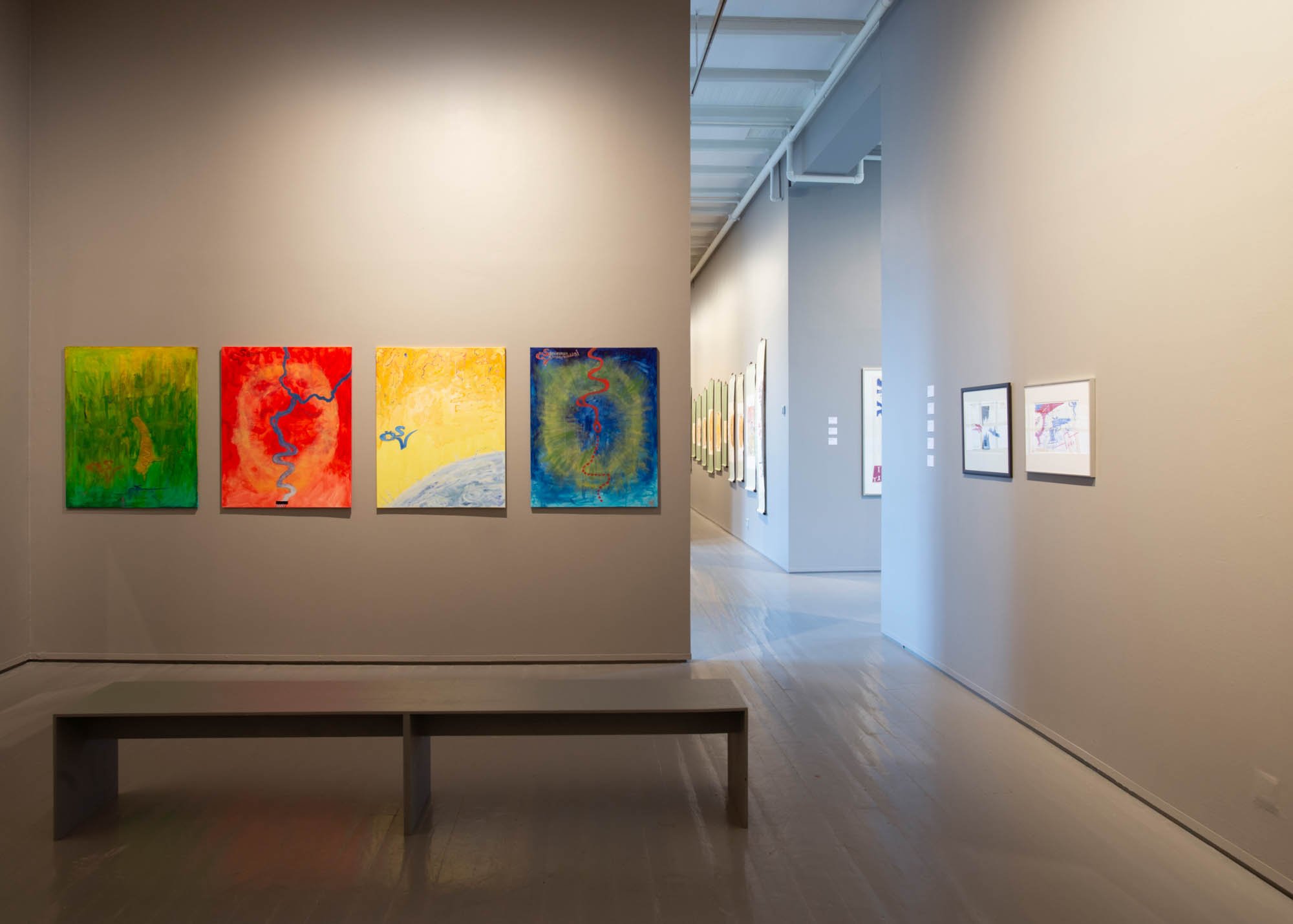
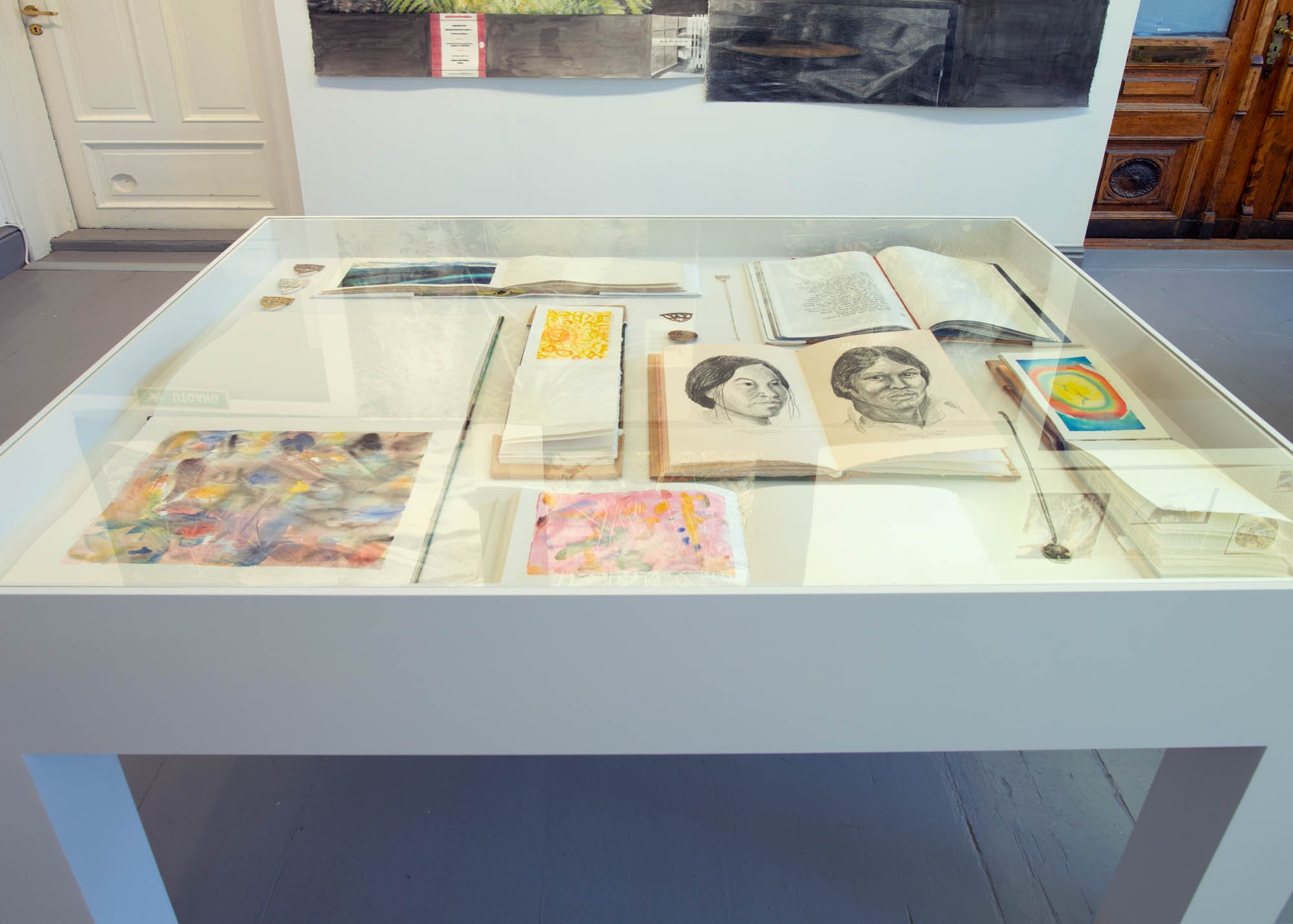
What is indeed striking when one looks at Elle-Hánsa’s artworks is both the range of artworks he is at home with, and the volume of his production. Paintings, woodblock prints, sketchbooks bursting with aquarelle, lithographs, but also jewelry, posters, poems, and of course the famous maps, which he is known throughout Sápmi for. One feels that Elle-Hánsa is a curious soul, who keeps an interest in many different subjects and techniques, and who has spent his life experimenting, travelling, discovering and exchanging with diverse people and cultures. As a result, his eclectic collection is a fascinating maze, which is united by some recognizable features: the strong presence of Sámi symbols, places and names; a strong leaning towards colorful watercolor landscapes, as well as daily scenes that include Sámi cosmology in his graphic works; and the use of handmade objects and natural materials, amongst which the sketchbooks and books that he binds himself, oftentimes using reindeer leather, recycled paper, and even his own shirts for the cover.
I have met Elle-Hánsa on many occasions, and one thing that strikes every time I see him, is that despite his old age, he is clearly a young spirit at heart, his eyes often sparkling with a hint of mischief when he is preparing a good joke, or when he is telling a funny anecdote. The same youthful sparkle can be seen when he teaches his craft or tells his life story. At the same time, he is a vastly experienced man and artist, who has applied a serious, hard-working ethic to his art for decades – resulting in a collection of artworks that numbers in thousands.
A young artist’s difficult childhood
Born in Áhkánjárga / Narvik in 1945, Elle-Hánsa went through very tough years as a child. From age 2 to 11 he was treated for tuberculosis at the hospital in Tromsø which is now known as Kysten[1] and seven of these years were spent bed bound.
These years have obviously left a mark on Elle-Hánsa, as a person and an artist: “My life changed because I lost 11 years. I was behind, you know, so I was a bit more childish than my contemporaries” he recalls. At the same time, “Lille-Ragnar” started drawing while lying in bed and looking through the window, and one of his nightmares depiction, the aquarelle drawing entitled Máná niekko, –… Stallo / Barnedrøm (1969), would later become his first artwork exhibited at the prestigious Høstutstillingen in 1970. At the TB hospital, he also tried his hand at the piano and the organ, during the last years he spent there and was allowed to finally get out of the bed and walk.
There was a tremendous amount of pain he had to go through during these years – both physically but also psychologically, due to the abuse he was subjected to and the forced separation from his family, his Sámi language and culture. Elle-Hánsa survived, and following his release of the hospital, he went to live with a foster family in Sálašvággi / Tromsdalen as his mother had remarried. His foster parents were north Norwegians, and as Elle-Hánsa explains, they had Sámi roots but lived at a time and place where it was better not to display one’s Sámi ancestry too obviously:
“You had to talk Norwegian, or else you would be killed –maybe not literally, but mentally. […] [My foster father] told me one time that he remembered some Sámi words. I was very pleased that it was possible to discuss. But that was many years later, after I had already left home.» [2]
He describes the years with his foster family as happy within the family circle, but difficult at school as he was bullied for being Sámi:
“I had dark hair and dark eyes and I guess I looked more oriental than I do now. They were calling me ‘finn-unge,’ which means Sámi bastard or something like that. (...) And a couple of times I was boxed down, and once I hit my head on the stone; I guess I woke up a bit later, but I was very scared. Of course. And the teachers were letting this happen. I didn't dare to tell them because that was not the thing to do as a boy. […]
One of the pupils even said to me – and that was when I was a bit older, «You should ask for forgiveness for being alive.» I was very shocked. I went home. I thought, why is it like that? Why should I be ashamed for being alive? So I stayed home the rest of the day. I was really shocked.»
Beyond the impact these childhood years had on his character, they also seemed crucial to the development of Elle-Hánsa as an artist.He tells me about his many childhood drawings, his strong interest in music, and that he would have loved to be a musician or composer if he had had the patience to stick to his piano lessons as a boy. I ask him if it was already clear for him at that time that he wanted to be an artist. His answer is without any hesitation:
“Yes. And also of course I had the sense of being Sámi.»
What did people around him think of being an artist then?
«They thought art, what is that? It's stupid. People making some dumb things. It's not real work. But then I asked my foster father. I asked, ‘Art, is that work?’ and he replied, ‘Yes. Art is work.’
The arduous path to becoming an artist
This clear awareness of both his artistic aspirations and his identity doesn’t mean that the path to living as an artist was easy. Elle-Hánsa graduated from the gymnasium – equivalent of senior high school – in 1966, with a thesis on the fall of the Incas. That fact may seem anecdotical, but if Elle-Hánsa likes to bring it up, it is probably because it showcases his interest in writing and geography, as well as his early awareness of colonization history – at a time when history manuals barely used the word colonization – and curiosity towards other cultures. This is also when he started to write poetry. He tells me, with a hint of pride:
«Maybe not many people know it, but I have written a lot. I had one of my poems in the Dagbladet [newspaper] once!»
Elle-Hánsa mentions several times during our conversation how the practical aspect of life is non-negligeable, especially as an artist – in fact, the first part of our talk that day focuses on the Beijing House restaurant of which he is the manager/daily leader, and how the restaurant managed to survive for 10 years despite the difficulties faced by small business-owners in Tromsø and the COVID regulations.
But back to 1967, with a young Elle-Hánsa freshly graduated, painting and writing, but needing to make a living. One of his teachers, now working in the municipal School office, suggested taking on a small school that lacked teachers. So in the autumn of that year, the artist arrives in Niehkut / Finnkroken on the picturesque Ráidna / Reinøya, north of Tromsø. He recalls:
«In the same room I had to teach the first, second, third, fourth, fifth, and sixth grade at the same time, in the same group. So that was quite impossible, really. But somehow I managed, I did it like this: I put the sixth and fifth grades to help the fourth and third grades, while I took care of grades one and two!»
He laughs heartily as he recounts his slightly unconventional techniques.
“I was very fond of music. So I taught them a lot of music history. Classical music.»
The stint as a teacher in Finnkroken didn’t last more than a few months, but in many ways it was a formative experience. He would go back to teaching as a side job several times in his career, but also, living in a community of both Norwegians and coastal Sámi, he gained new insights into his own identity. I ask him what he had been taught about Sámi history and art during his own high school time:
“You know, in school we learned very little about the Sámi; just that they live in Finnmark and live from reindeer, but I was a coastal Sami, and they were disregarded and it was the purpose of the government to Norwegianize them in a very harsh way.”
First milestones and success
Following this teaching experience, Elle-Hánsa started studying at the music conservatory in Romsa / Tromsø, but continued writing and painting on the side. He also worked as a technical drawing assistant at Harry Gangvik Architect Company in Tromsø in 1968, which was not only in line with his love of drawing and his interest in geography, but also the foundation of what would turn out to make him known to the public: his groundbreaking maps of Sápmi.
But in 1969, his art career started to take off, as his theatre play Bjørnefesten, which takes up the topic of colonization, Sámi culture and the importance of indigenous place names, was awarded a prize at Festpillene i Nord-Norge 1969 in Harstad. That same year, two of Elle-Hánsa’s paintings were featured at the regional exhibition Nordnorsken, which took place in Tromsø that year.
Following the Høstustillingen in 1970, and the success he started to enjoy, the young artist entered Oslo’s Art and Crafts School, which he attended from 1971 to 73, and after that the State Art Academy, also in Oslo, from 1974 to 1979, with a two-year break in between to travel abroad. From then on, he would devote himself almost exclusively to art. He credits the school for the diversity of techniques he experimented with and later used. He did find out that, apart from his fondness for watercolors, he had an inclination towards lithography and woodblock printing. John Savio was among his inspirations:
“Of course, you know, when I first thought about the woodblock print, I looked to Savio because he was very well-known as an artist in the north. And I went and saw some of his prints at the national gallery and it was also inspiring me to work with woodblock print. Then when a colleague and friend of mine saw my first woodblock prints, he commented, ‘Oh, this looks very much like Savio,’ and of course he was right, but I didn't like that! […] So, from there on I went my own way: Savio has very few color prints, if any. His color prints are colored after they have been printed. So I used colors in my prints.”
An activist artist
The ties between Elle-Hánsa’s art and activism also became much stronger at that time. He became the chairman of the Oslo Sámi association, and met young artists as well as activists who would soon illustrate themselves in the fight for Sámi rights and for the revitalization of Sámi culture, notably Mikkel Hætta, Ante Gaup and Berit Marit Hætta from Máze, among others.
The period stretching from the 70s to the middle of the 80s was a period of intense activity for Sámi activists and for Elle-Hánsa on many fronts. In 1972 there was a literature seminar in the village of Sirbmá in the Deatnu valley, which Hans Ragnar followed with strong interest. It was at this seminar that the slogan ČSV, usually translated to Show Sámi Spirit (but that can also be declined into other meanings), became a vector in the promotion of Sámi culture and the establishment of a new spirit to replace the shame and fear of previous decades.[3]
In 1974, 29-year-old Elle-Hánsa drew his first map, entitled Sábmi, which he later offset printed to make it easily accessible, hoping it could be distributed to school classes. The inspiration for this first map was his strong interest in geography, his activism, and the map of Tromsø AMT, which he had seen years before. The Tromsø AMT map, estimated to be from 1872, had Norwegian and Danish place names, but also Sámi ones. It is believed that that map was itself based on the Lapp Codicil of 1741, which delimited the pastures of reindeer herding Sámis at the time. That map had made a strong impression on the artist, and inspired by the drawing techniques he had witnessed when working at the architect’s bureau, he had the idea to trace his own map of Sápmi with a pencil, and to add Sámi names to it. He brought the blueprint of the map to the Sáminuorra (Sámi Youth Conference) that took place in 1974 in Ammernjárga. The map, as well as the ones that came next, became a reference in that they showed visually the geographical unity of the Sámi people, and literally placed them on the map of the world.
There were many milestones for Elle-Hánsa at that time, amongst which a solo exhibition in Guovdageaidnu / Kautokeino, which was very important for the artist, as he had been discussing returning to the north and forming an artist collective with other artists such as Berit Marit Hætta. The establishment and importance of this upcoming artist group for Sámi arts and for Norway in general has been described in detail in the remarkable book from Susanne Hætta, Mázejoavku. Indigenous Collectivity and Art (Office for Contemporary Art Norway / DAT, 2020), which I cannot recommend enough. All of this took place on the background of the growing protests against the Alta dam, which would turn out to be one of the most significant demonstrations in Norway for Indigenous rights as well as for the environment.
The Máze years
Between 1976 and 1981, Elle-Hánsa divided his time between extensive travels to other Indigenous lands, designing posters and making maps, and participating in exhibitions such as the one at Galleri Alana in 1978. It’s also during the 1970s that he designed one of the logos for ČSV. He also suggested hunger strike as a better strategy than violence.
When I ask Elle-Hánsa which period of his life he considers the most productive, he replies straight-away, “My first time in Máze.” But also when he went back to Máze after a travelling break, in 1981:
“Then I decided that I am going to work very hard and not take part in social gatherings at all. I did a lot of bookbinding at that time, and also woodblock prints and stuff. […] So that was one of my most creative periods, creating everyday.” [4]
Apart from the creative emulation of the Mázejoavvku and the increased proximity to his identity as a Sámi man, the Máze period also offered the artist the chance to be closer to nature:
“I also went skiing a lot when I was in Máze. And during those ski trips past the mountains, I got inspiration to create new pictures, new woodblock prints.”
I remark on his connection to mountains and particularly to Sálašoaivi / Tromsdalstinden, the sacred mountain overlooking Tromsø:
“Yes, it's a very close relationship because the mountain warned me in a dream that I would have to protect it in the future. That something was going to happen that would endanger it. I was very bewildered. And I suddenly woke up, and wondered what was that about. Then I went to sleep again, and I guess I promised to do that. When I fell asleep, I saw the mountain was all gold. So I have a close relationship with that mountain. […]
When the plan for the winter Olympics here in Tromsø came up, I saw they had planned to make a downhill slope on Sálašoaivi. And then I wrote strongly against it. I got very popular at that time. Even though some people, including a Sámi artist, were against me.”
A long way to recognition
One thing that comes back up several times during my 2-hour long conversation with Elle-Hánsa is that there has been some opposition against him as an artist. He mentions it right away when I ask why it took so long for him to have a solo show at the Kunstforening in Tromsø, his adoptive city. He also describes not being invited to important exhibitions when he was a young artist, and that this contributed to him turning to map-making and art teaching at times.
He credits the Kunstforening’s intendant, Leif Magne Tangen, and Árran’s curator Gry Fors for deciding to make the long-due retrospective happen. I ask him what he thinks the source of the hostility he faced could be. He pauses and thinks, then says:
“Maybe envy? That's the natural thing. People get envious, so it’s not surprising.”
The exhibition at the Kunstforening also arose in the context of Elle-Hánsa having donated most of his artworks to the Árran Lule Sámi art center, which he chose because of his connections to family and friends from there. Ever the practical, down-to earth and humble person that he is, he describes his donation in prosaic terms:
“The reason why I gave Árran so many things is that I simply didn't have room at home anymore. Otherwise I would have kept them. So it's not as heroic as one might think,” he says with a smile.
And yet that must not have been an easy choice for him to part from his vast collection. As he explains to me, he is very attached to his works:
“You know, I was making paintings and watercolors, but I didn't want to sell them because I grew too attached to them. They were like children in a way.
So I thought, well, I can't live as an artist and not sell, so I have to do something. Now I know, I will do graphic art, woodblock prints and lithographs. That way I can both keep and sell!”
He laughs his characteristic laughter, the one that means he has found a good trick.
The Sámi drums and Daisy’s good word on religion
He sounds particularly happy when he talks about the series of drum prints that Árran, with help from the Sámi Parliament, bought in its entirety. He wouldn’t have wanted the drums to be separated. He worked on them for around 5 years in the beginning of the 90s, and wanted to make woodcut replicas of around 30 of the most representative patterns found on traditional northern Sámi drums, the instrument of the noaidi or shaman. He then mounted the prints on Chinese scrolls, as during a trip to China and Mongolia, he showed some reproductions of the drums to the people there, and they exclaimed that the Sámi drums were like their own.
The strong symbolism of these shamanic drums and the presence of the Sámi cosmology in a lot of his artworks prompts me to ask Elle-Hánsa about his relation to religion: he described earlier going to church often, and having made a plaster copy of Michelangelo’s Madonna and child, which is now at the Elverhøy church in Tromsø. How does he reconcile the two? As often, his answer comes in the form of an anecdote:
“Good question. Well, when I was in Canada, I stayed with an honourary chief, David Crowchild in Calgary, for quite some time.
And then in a meeting, this American priest, asked him, ‘How do you see that your traditional religion relates to Christianity?’ And he asked in a kind of inquisitorial way. And Daisy, David’s wife, said:
‘Oh, it's all the same. We do the same things. And the only thing I worry about now, is if my dog is coming back or not.’
I thought that was so funny and so straight on. And she gave the right answer.»
He laughs boisterously as he recounts this particular anecdote, and his contagious laughter makes me join in on the laughter.
Looking ahead
I ask if the opposition he has faced earlier has faded, and if he feels it is easier for younger generations to accept their Sámi identity.
“I think so. They often refer to us older artists as being the inspiration. This is a nice feeling. Yes, of course it is a really good thing.”
And what does he hope for them?
“Normally when old artists say something about the future, it never happens like they hoped. I can only say what I wish. I wish them good luck and to continue the work to enrich and elevate Sámi art, culture and society, because we are not a Norwegian minority. We are an inter-Nordic people and an international people.”
As we finish our food and prepare to say goodbye, I congratulate him one more time on the exhibition at Tromsø Kunstforening and asks him if he is satisfied. He replies philosophically:
«I have found out that, of course it is very fine, that exhibition, but also I'm going to have a separate exhibition here in this restaurant. Actually I was thinking of hanging it up today, but I am a bit delayed. I will work on it tomorrow.”
The exhibition ČSV- Terra Cognita will tour northern Norway in 2022.
This interview was conducted in November 2021 in Tromsø by the author.
Footnotes
In 1991, the old hospital was transformed into an artistic center comprising around 40 artist studios and workshops, under the name Troms Fylkeskultursenter. Elle-Hánsa got one of the first studios and chose one of the rooms in which he had been hospitalized as a child.
Elle-Hánsa also mentioned that his foster-mom had met Elsa Laula Renberg, who was at the time “a Sámi queen”, and that she remembered her very well.
The slogan’s attribution is disputed: in her book, Susanne Hætta attributes it to Anders Guttormsen; Elle-Hánsa mentioned its use by Johan Jernsletten, the brother of Niels Jernsletten, who was Elle-Hánsa’s Sámi language teacher; Nils and his wife Laila became like parents to him. He described Nils to me as his “Sámi godfather.”
He also mentioned that 2003 was his other most creative year.




